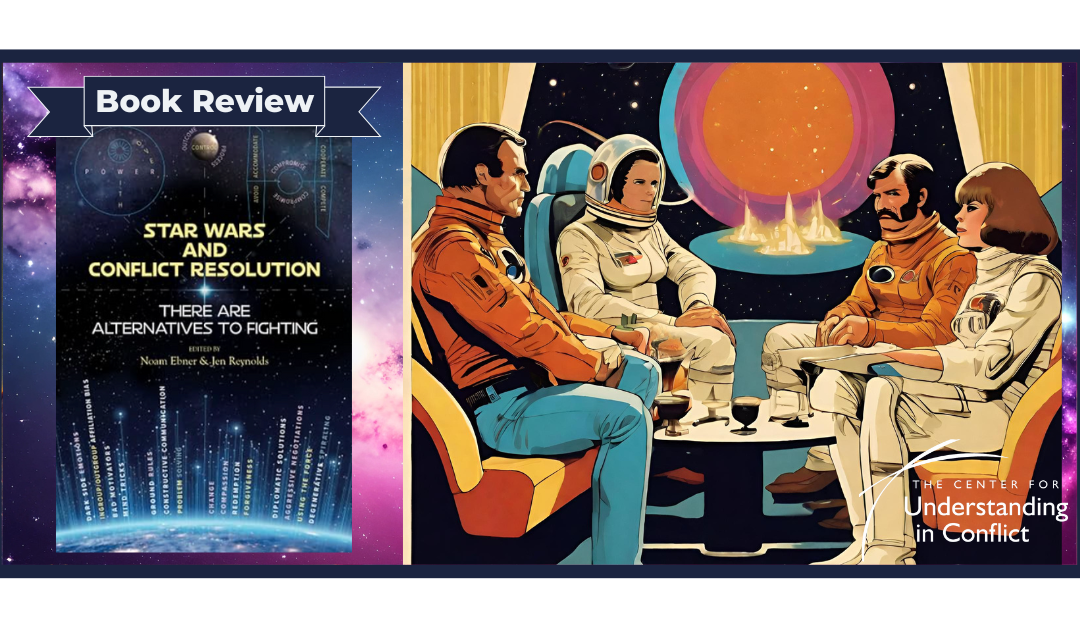In the vast universe of conflict resolution literature, Star Wars and Conflict Resolution by Noam Ebner and Jen Reynolds stands out as a unique and captivating exploration of the intersections between the iconic Star Wars saga and the principles of conflict resolution. As lightsabers clash and starships soar through the cosmos, Ebner and Reynolds skillfully weave a narrative that celebrates the epic space opera and delves deep into its potential for teaching valuable lessons about mediation, negotiation, and peacemaking.
The authors begin their journey by drawing parallels between the Force and conflict resolution techniques. They argue that certain universal principles bind conflict resolution methods just as the Force binds the galaxy together in Star Wars. From active listening to empathy and negotiation strategies to transformative mediation, “Star Wars and Conflict Resolution” successfully bridges the fictional and the practical, inviting readers to explore the forceful dynamics that shape conflicts in both galaxies.
One of the book’s standout features is its exploration of key characters and their roles in conflict resolution. The authors meticulously dissect the actions of beloved characters like Luke Skywalker, Princess Leia, and Han Solo, highlighting how their interactions exemplify conflict resolution strategies. Luke’s journey from farm boy to Jedi Master becomes a metaphor for personal growth and conflict transformation, giving readers a fresh perspective on their potential for change in the face of conflict.
Princess Leia, a symbol of resilience and leadership, becomes a case study in negotiation and diplomacy. Ebner and Reynolds deftly analyze her diplomatic endeavors, showcasing how she navigates the complex political landscape of the Rebel Alliance. By drawing lessons from Leia’s experiences, the book successfully emphasizes the importance of diplomacy in resolving conflicts on both personal and societal levels.
Han Solo, the charming scoundrel, is a focal point for exploring trust-building in conflict resolution. Through Solo’s tumultuous relationship with the Rebellion and his love interest, Princess Leia, readers gain insights into the fragile nature of trust and the potential for its restoration, a crucial aspect of successful conflict resolution.
Topics also delve into the darker side of conflict, exploring the Sith’s manipulative strategies and how they can be understood through the lens of destructive conflict resolution. The authors skillfully draw parallels between the Sith’s lust for power and real-world conflicts driven by greed, ego, and unchecked aggression. By examining the consequences of embracing the dark side, readers are prompted to reflect on the destructive paths they may unwittingly tread in their conflict resolution journeys.
Ebner and Reynolds seamlessly blend academic rigor with pop culture analysis, making the book accessible to a broad audience. Including real-world examples and case studies further solidifies the practical applicability of Star Wars-themed conflict resolution techniques. This approach not only engages fans of the saga but also serves as a gateway for those new to the concepts of conflict resolution.
The book’s structure enhances its accessibility, with each chapter focusing on a specific aspect of conflict resolution and its manifestation in the Star Wars universe. This organization allows readers to navigate the book quickly, making it an excellent resource for casual readers and conflict resolution practitioners.
Star Wars and Conflict Resolution is a tour de force that seamlessly melds the worlds of fantasy and practicality. Noam Ebner and Jen Reynolds have crafted a compelling narrative that not only celebrates the enduring legacy of Star Wars but also transforms it into a valuable tool for understanding and navigating conflicts in our lives. Whether you are a Star Wars fan or a conflict resolution enthusiast, this book offers a fresh perspective on timeless principles that can guide us toward a more harmonious and just galaxy, both near and far, far away.
